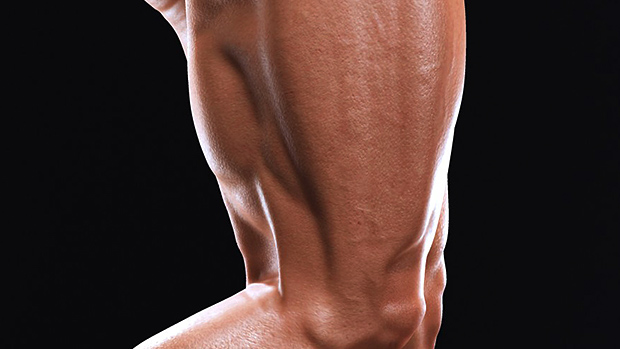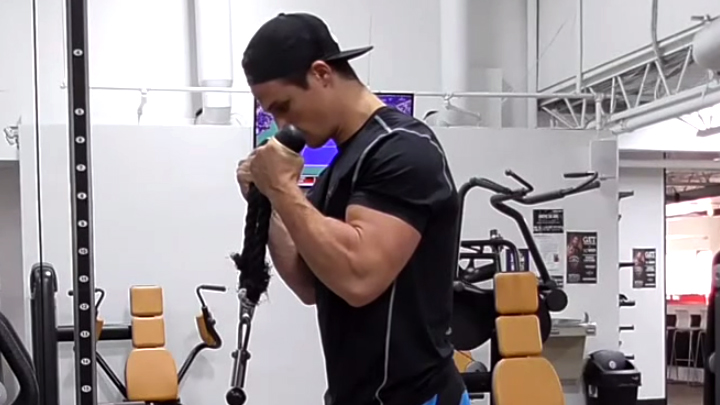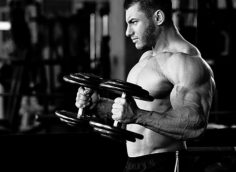The Straight Dope
I'm a straightforward guy; I don't like to hide my intentions behind a lot of unnecessary words. People who do that are often trying to sound more intelligent than they are, or trying to hide the fact that they don't know what they're talking about! A few years back I came up with a simple maxim:
Complexity is the language of simple minds.
Always be wary of the guy who sounds impressive. The more complex a sentence is, the more likely it is to contain a lot of hogwash. That's especially true in the fields of athletic conditioning and bodybuilding.
So, allow me to speak simply and clearly: I have yet to see a single athlete with adequate hamstring development. Every athlete I've seen has either non-functional or unbalanced hamstrings. This probably applies to you as well; therefore, you'll benefit from a few special hamstring exercises. How's that for no-bullshit honesty and straightforwardness?
I'm going to give you a list of the most effective hamstring exercises you can perform without having to use expensive and hard to find equipment. But before we get to that, let me expand a bit on my statements above:
The hamstrings are key to sport performance. Without powerful hams, you can't run fast, you can't jump high, and you can't be explosive. There's no way around it! Furthermore, having strong hamstrings is one of the best ways to prevent knee and quadriceps injuries. Finally, a strong set of hams helps improve posture by preventing excessive lumbar lordosis and hip anteversion. So in that regard, I haven't worked with a single athlete who couldn't benefit from extra hamstring work.
In all fairness, not all the athletes I've seen have had bad hamstrings, however, most do have some problems. The most frequent problems I've seen are:
- Disproportionate knee flexion and hip extension capacities. Many people are strong in a knee flexion (e.g. leg curl) movement but are weak in a hip extension movement.
- Hamstrings are too weak compared to the quadriceps and illiopsoas. Even if an athlete has strong hamstrings, having monstrously strong quads will create problems. Also, the stronger the IP muscle is, the stronger the hams need to be. Since most athletes have a very strong/tight IP, the hamstrings must be worked in their hip extension role (since the IP is a hip flexor).
In short, every athlete wants to run faster and avoid injury, thus they can all benefit from extra hamstring care. So can you!
The Painful Seven
Two of the greatest hamstring exercises in the world are the reverse hyper and the glute-ham raise. If you have access to a reverse hyper and a glute-ham bench, you're a lucky dog because you have all you need to get strong hams. However, most of us aren't so lucky; these machines are expensive and it's rare to find a gym that has them. We must find other exercises that can be performed with "regular" gym equipment that will give us equal results.
Here's a list of the seven best hamstring exercises you can perform at a regular gym. Since some lifters may find one exercise better suited for them than others, the movements below are listed in no particular order.
1 – One-Leg Back Extension, a.k.a. "The Titanic"
This exercise can effectively replace the reverse hyper. While it's not as effective as a prehabilitation tool when it comes to increasing hamstring strength, it's up to par. It's also a great way to increase the hip extension function of the hamstrings.

Starting Position: On the hyperextension bench, the working leg is anchored under the pad while the other leg is left free above the pad. The trunk is flexed toward the ground and the arms are extended.

Execution: Simultaneously do a back extension and a hip extension with the free leg (bring it up). During the back extension you must concentrate on driving your working leg in the pad. You may or may not yell "I'm the king of the world!" at the completion of a rep.
2 – Natural Glute-Ham Raise
This is a simple, yet humbling exercise. The goal is to kneel down and try to lower your torso to the ground under control, then bring yourself back up. Very few athletes can actually bring themselves up at first, so you might want to help yourself with a little arm push to get you started off the ground. This is a great exercise to develop the knee flexion function of the hamstrings.

Starting Position: Kneel down and lock your feet under something solid and heavy (a partner can do just fine, but he must be able to hold you down). The trunk is upright and the arms are alongside the body.

Execution: Lower yourself as slowly as possible. To do so you must produce a powerful hamstring contraction or else you'll find yourself embedded in the floor! If you're able to bring yourself back up on your own, do so, but most guys (and gals) will need a little push-off with the arms to get moving.
3 – Scissor Hip Extension
This is yet another simple drill that requires little equipment; you only need a bench or other elevated surface. This is a favorite of many top sprinters; it really develops the hip extension function of the hamstring as well as knee stabilization.

Starting Position: Lie down on the ground. Both feet (heels specifically) are placed on the bench. The legs are slightly bent.

Execution: Perform two movements at the same time. First, bring the non-working leg towards your chest (hip flexion and knee flexion). Second, lift your hips off the ground by driving the working leg through the bench. Both movements must be executed as fast as possible.
4 – Leg Curl
Listen, all machines aren't evil and worthless. Case in point, the reverse hyper is a machine and it's great!
The leg curl has received some criticism because it neglects the hip extension function of the hamstring. If it's the only hamstring exercise you use, yes, that can be a problem, but as part of a complete hamstring program it certainly has its place. For one thing, the leg curl is very effective at increasing the knee flexion role of the hamstrings.
I don't feel that it's really necessary to explain how to perform a leg curl as it's quite common in all gyms.
5 – Plate Drag
T-mag has written about this uncommon exercises before in its Short Topic series, but I'm going to present a different variation here. This extremely simple movement is a fantastic way to develop hamstring strength and power in a very sport-specific manner. Furthermore, since it doesn't have an eccentric (negative) portion, this exercise will lead to little micro-trauma and thus little, if any, soreness. For that last reason it's a favorite of several track athletes since running on sore hams is brutal and dangerous.

Starting Position: Lie down on the ground and hold on to something to brace yourself. Your legs are fully extended and the working leg is sitting on a weight plate (25, 35 or 45 pounds), preferably with the heel in the plate's hole.

Execution: While keeping your body stable, slide the plate towards you by contracting the hamstring muscles of the working leg. The opposite leg stays extended.
6 – Band Stomp
This is a common exercise at Westside Barbell Club, which is known for developing inhumane squatting strength via hamstring strengthening. This exercise is a great way to finish off the hamstring muscles after an intense workout. It's also a fantastic drill to increase running speed.

Starting Position: Tie one end of a Jump Stretch band to the safety pins of a power rack (or to the bar which is sitting on the J-hooks). The height at which you tie up the band will determine how much tension there'll be (higher equals more tension). You want to use a height setting that'll allow you to make rapid, yet challenging movements. For most people that'll be a setting in which the loose end of the band is at the mid-thigh level. Once the band is tied up to the rack, you put your working foot on the opposite side of the band and you hold on to something for stabilization.

Execution: This movement is simple – you stomp the ground slightly behind you, then bring the leg back to the starting position (actually, the band will do that for you). The goal is to do as many reps as possible in a predetermined time frame (15 to 30 seconds), so the reps must be fast and the turnaround speed must be high.
7 – Stiff-Legged Good Morning, a.k.a. The Russian Deadlift
A list of hamstring exercises wouldn't be complete without some type of good morning! I prefer the stiff legged version for hamstring development as you can get a fantastic stretch at the same time.

Starting Position: Stand upright with the bar on your shoulders like you would at the beginning of a back squat. Use an intermediate grip.

Execution: While keeping the legs straight, bend the trunk forward and bring the hips backward, then get back up.
Conclusion
When properly used, these exercises will improve speed and explosion beyond belief. As an added bonus, they'll also make your squat skyrocket, and if you're a bodybuilder you'll likely experience some shocking growth!
Understand that you should not do all of these in the same workout, especially if you like walking like a normal human being! Instead, experiment to find which exercises work for you and give them your best shot!





